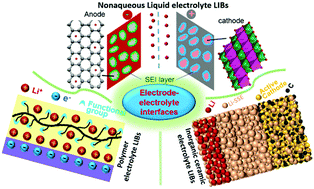Electrode–electrolyte interfaces in lithium-based batteries
Abstract
The electrode–electrolyte interface has been a critical concern since the birth of lithium(Li)-based batteries (lithium or Li+-ion batteries) that are operated with liquid electrolytes and in recent years to increase the operating voltages. The electrode–electrolyte interfacial behavior has also been in sharp focus with respect to intensively pursued solid-electrolyte-based (polymer- or ceramic-electrolyte) lithium and Li+-ion batteries. Understanding the relevant chemical/electrochemical reactions, structural/compositional characteristics, and thermodynamic/kinetic behaviors at the electrode–electrolyte interface is of paramount importance for the development of strategies to enhance overall battery performances. Although the relevant research has been emphasized for many years, both a fundamental understanding of the interfacial phenomena and the practical strategies for enhancing the interfacial properties are still limited or vague. Due to the complexity involved in the interfacial behavior, the future research and development require collaborative efforts involving the disciplines of chemistry, physics, materials science, nanoscience/nanotechnology, as well as computational modeling/simulation. This review presents the key findings, recent progress, current status, and a bold perspective/vision for further understanding and manipulating the electrode–electrolyte interfaces in lithium and Li+-ion batteries. The information provided in this review is expected to benefit the current Li+-ion technologies and future-generation solid-state lithium and Li+-ion batteries that are based on polymer electrolytes or ceramic solid electrolytes.



 Please wait while we load your content...
Please wait while we load your content...